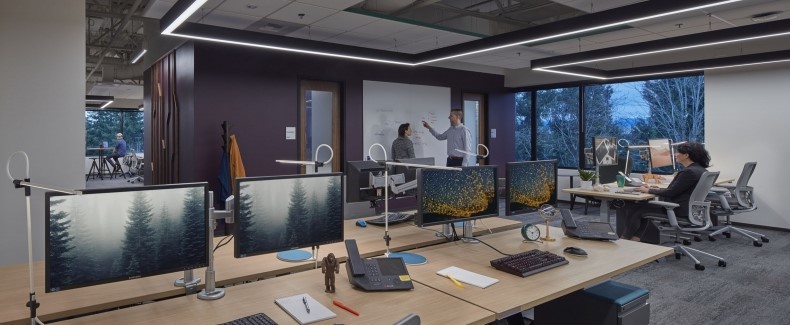
Data Driven Design: New Workplace Metrics For Productive Workplaces
How can design enhance individual and team behavior in the areas of work performance, the ability to innovate, and the chance to connect within and across teams? These are questions our real estate team is using data to address. Traditionally, real estate organizations have used data as a means of keeping costs under control. Now we are looking to use data for enhancing the productivity of individuals and teams to boost business performance.
To achieve this, our real estate team is partnering with some of our product groups—Azure Digital Twins, Workplace Analytics, and others—to build a data and analytics platform that will enable us to model the ways employees interact and intersect with individuals and teams in given physical environments. When these platforms are fed with multiple streams of data, with the help of machine learning algorithms, they become powerful tools both for visualizing how employees are using our spaces and predicting how they’re likely to use them, enabling us to respond proactively with changes.
This means that whatever the design intervention—creating spaces for multipurpose activities, for example, or creating spaces that can shrink or grow depending on the need—we can measure impacts on users. We collect the data in two ways: self-reported through employee surveys, interviews, focus groups, and research specific advisory panels; and measured by anonymized workplace analytics from building sensors, Wi-Fi connections, and other passive data sources. Though the latter delivers less biased data, the former is equally important as an indicator of how employees think about their work environment. These insights enable Microsoft’s real estate team to make design changes which enable employees to do what they need to do: focus more, collaborate more, or even move to another space.
In early implementations of measuring productivity with data, we’re seeing revealing results. When we converted some of the Puget Sound campus buildings which house engineering teams from private office environments to team-based spaces, we compared pre- and post-renovation data on meeting duration, meeting attendance, network size, frequency of collaboration, and so on. Though it’s too early to ascribe causality, the data shows that work in the new spaces has coincided with a decrease in time spent in meetings and an increase in collaborations across teams, to name just two outcomes.
And the data tells us even more about how employees work. New employees benefit richly from ready access to tenured employees and report more productivity in team-based workplaces than traditional open plan settings.
Other data about workplace density has revealed advantages of team space. We have learned that team productivity generally increases as density decreases, but only to a point. We’ve found evidence of an optimal density range where the benefits to team productivity are highest. However, we’ve also learned that if density decreases beyond this optimal range, we find that team productivity can suffer. We’re working to identify just where those limits are within different work groups.
Indeed, the data consistently reminds us that one size does not fit all. In the past, real estate organizations have generally treated workspace as a fixed asset with same-size spaces, layouts, and furnishings. We know from our research that delivering the same workspace to different teams, even in the same organization, is not optimal: hardware engineers have different needs from software engineers who, in turn, have different needs from salespeople.
Data insights allow us to understand work processes, the social networks in an organization, and how collaboration between teams happen within a given workplace. We are finding ways to create flexibility, which can accommodate different usage patterns across a given week, or along a project continuum. Knowing how space use changes based on cyclical deadlines, seasonal holidays, intern rotations, and even Fridays, allows us to be more agile and responsive to reflect actual user needs.
Leveraging broader data sets to find more tangible connections between the performance of individuals and teams and the spaces they occupy is Microsoft real estate’s ongoing initiative to make workspaces better for the employees who use them—and outcomes better for the business as a whole.

I drive Employee Experience through Workplaces and Real Estate. I am a Certified Executive Coach.
4y“1 size does not fit all!” - agree 100%. Leveraging data and performance measures push the insights we gather to collective build better bespoke spaces. The one area where we hope to influence more.. is the why? Why do people prefer to work here not there? What are people’s sentiments to space choice and use? And how do we know they change?... a myriad of questions.. where data sometimes does not get to..
VP, Partnership and Funding @ IdealZ International | Connecting Asia's Infrastructure Stakeholders
4yInteresting trend...
Design Researcher + Strategist
4yThrough what analytical/interpretive procedure (or theoretical basis) will you come to understand the intersect of non-spatial organisational structures and spatial ones? It seems to me that the gold standard for a business-aligned workplace is one designed with variables like goal, leadership, strategy, culture, performance criteria, horizon/risk, growth, and capability types that are unique to businesses (and perhaps more specific even than Sales vs. Engineering, or even hardware vs. software vs. cloud engineering). How will the data generated by your new research tools become holistic workplace design recommendations, implemented as a strategic counterpart to these other org features?